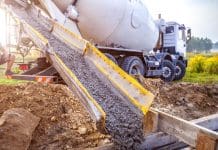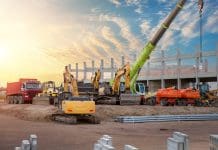Sam Tracey discusses five eco-conscious ways to lower the construction sectors carbon footprint and make a greener construction site
The construction sector contributes nearly a quarter of all global air pollution, giving it one of the worst environmental footprints of any industry. With a high demand for materials and resources, plus fuel-guzzling machinery on sites, it’s no surprise construction businesses struggle to keep their carbon footprints low.
However, construction companies are under increasing pressure to make positive changes to their emissions, and those leading the way are set to reap the rewards of better brand reputation and consumer trust.
So, what are the first steps eco-conscious companies can take towards greener construction?
Certify your projects
Taking steps to improve your environmental impact is a positive start, but if you’re not being held to any standards, it’s easy to let the quality of your eco-efforts slip.
There are third-party certifications available, which assess your project work to ensure you’re meeting the latest environmentally friendly standards. Certifications like BREEAM review and validate construction projects based on their sustainability.
They also continuously update their methods to meet the latest innovations, so you’ll always be held accountable to the highest possible standards.
These certifications work with you at every stage of your projects – from planning and design to greener construction and future-proofing – meaning you won’t get caught short at any time or waste time and resources on any work that doesn’t meet sustainability standards.
The benefits of gaining independent certification extend to reputation management, too. In today’s eco-conscious society, demonstrating your commitment to environmental sustainability could put you ahead in the competition for business.
Tech advantages
As with most industries, the emergence of new technologies, replacing traditional paper and pen processes, plays a role in helping construction companies reduce their carbon footprint.
For example, building information modelling (BIM) revolutionised construction project planning, allowing everyone involved in a project to access information on one single interactive platform. Employees can ‘walk through’ a 3D plan, view financial details and more on an online platform, removing the need for multiple paper sketch drafts.
The ability to plan every detail of a project, plus theorising plumbing and mechanical work in a 3D plan, saves on wasted materials in the building stage from unexpected problems.
Daily project management and collaboration tasks can be moved online, too. Tools like Slack and Microsoft Teams provide a real-time digital communication platform, plus online project tools like Google Sheets allow employees to share and access information from anywhere, simultaneously, without the need for paper.
Fuel efficiency
Vehicle fuel is one of the construction industry’s biggest emissions, with large sites requiring heavy-duty machinery like excavators, bulldozers and trencher machines to carry out large-scale tasks.
While these machines can’t be replaced, there are ways to reduce the extent of their environmental impact. One simple – but often expensive – the solution is to invest in more efficient vehicles or greener fuel alternatives.
In the US, the Clean Construction USA programme has been launched in a bid to reduce emissions from construction equipment. The key drivers of the campaign are reducing vehicle idling, encouraging businesses to fit technologies like diesel particulate filters (DPFs) and switching to cleaner fuels.
The programme offers tips on how to make these changes and even provides funding opportunities for some construction companies to help initiate greener construction. As programmes like this become more popular and spread globally, we’ll begin to see more businesses take notice of the changes they can make themselves.
Another method is to reduce mileage. Telematics equipment can be added to construction vehicles to track location and hours of use, giving managers a view on how they can make equipment usage and movement around the site more efficient.
In addition to the obvious business benefits of reducing inefficient performance, environmental benefits are significant.
Route planning at the beginning of new projects also means you can produce site maps, which ensure all employees know the most efficient route and prevents wasted journeys.
Re-use and recycle
Construction projects see a lot of waste, but not every material needs to be sent to the skip. Understanding some of the items you can re-use, recycle or upcycle could see you cut waste dramatically.
Housing construction projects could yield flooring, doors, windows, bathtubs and sinks, cabinets and more, suitable for recycling or for being used on a future project. Even for materials that can’t be recycled, you can still play a part by working with removal services that have a greener track record to minimise the emissions caused by your work.
There are also plenty of materials which can be upcycled for use in different projects. For example, plastic and composite lumber can be used as landscape edging thanks to its durability. Similarly, broken concrete makes attractive paving and can be used in walls or paths.
Patios, decking and walkways are perfect opportunities to use re-use materials, with builders able to create unique and attractive crazy paving designs from odds and ends.
When it comes to sourcing materials for new-build or development projects, make sure you speak to suppliers about how they acquire their materials. You may be able to find suppliers who value environmental friendliness and sustainability in their processes, who won’t cost more than your regular supplier network.
The power of people
The key to any effective environmental initiative is getting buy-in from the whole workforce. Everyone needs to understand their role and be motivated to play their part. However, you need to make sure your new guidelines and initiatives clear, so they know exactly the goals they’re working towards.
Employees need to be made accountable for their own sustainable actions, and the best way to achieve this is ordering inspections at every stage of the construction process. This way you stay on track of what’s happening and identify issues as early as possible.
Provide actionable advice at each stage of your construction projects so employees know where they can improve and what they can do differently. This also shows your commitment to the goal which will translate to your employees.
Affirm your business’ buy-in to the cause by rewarding employees for successfully implementing changes, as a motivational tool.
Sam Tracey
SHEQ Advisor














